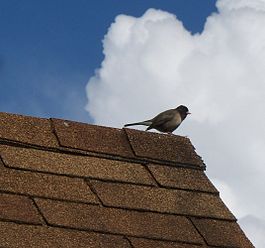Asphalt shingle

An asphalt shingle is a type of roof shingle. They are one of the most widely used roofing covers because they are relatively inexpensive and fairly simple to install.
Types
Two types of asphalt shingles are used: organic and fiberglass or glass fiber. Organic shingles are generally paper (felt) saturated with asphalt to make it waterproof, then a top coating of adhesive asphalt is applied and ceramic granules are then embedded. In the case of algae-resistant shingles, a portion of the granules contain leachable copper ceramicly coated, designed to protect against discoloration from algae on the roof. This does not protect from moss growth but does slow the growth. Moss likes to feed on algae and any other debris on the roof. Most manufactures offer a 5- to 10-year warranty against algae growth; 3M (scotchgard TM) offers a 20-year warranty.
Shingles are judged by weight per square. Organic shingles contain around 40% more asphalt per square (100 sq ft.) than fiberglass shingles. This makes them heavier and gives them excellent durability and blow-off resistance. But this extra needed asphalt makes them less environmentally friendly (despite its "organic" nickname). The paper-based nature of "organic" shingles leaves them more prone to fire damage, and their highest FM rating for fire is class "B". Shingle durability is ranked by waranteed life, ranging from 20 years to 50 years; in some cases lifetime warranties are available.
Fiberglass shingles have a base layer of glass fiber reinforcing mat. The mat is made from wet, random-laid fiberglass bonded with urea-formaldehyde resin. The mat is then coated with asphalt which contains mineral fillers and makes the fiberglass shingle waterproof. Fiberglass shingles typically obtain a class "A" fire rating as the fiberglass mat resists fire better than organic/paper mats. Fiberglass reinforcement was devised as the replacement for asbestos paper reinforcement of roofing shingles and typically ranges from 1.8 to 2.3 pounds/square foot.
The older asbestos versions were very durable and hard to tear, an important property when considering wind uplift of shingles in heavy storms. Fiberglass is slowly replacing felt reinforcement in Canada and has replaced mostly all in the United States. Widespread hurricane damage in Florida during the 1990s prompted the industry to adhere to a 1700-gram tear value on finished asphalt shingles.
A newer design of fiberglass asphalt shingle, called laminated or architectural, uses two distinct layers which are bonded together with ashalt sealant. Laminate shingles are heavier, more expensive, and arguably more durable than traditional 3-tab shingle designs. Laminated shingles also give a more varied, contoured visual effect to a roof surface.
Per 2003 International Building Code Sections 1507.2.1 and 1507.2.2, asphalt shingles shall only be used on roof slopes of two units vertical in 12 units horizontal (17% slope) or greater. Asphalt shingles shall be fastened to solidly sheathed decks.
Durability
Asphalt shingles usually last longer in cooler climates than warmer ones. Thermal shock is one thing that is damaging to shingles (thermal shock is what roofing materials experience when the ambient temperature changes dramatically within a very short period of time). Another factor affecting asphalt shingle roofs is attic ventilation. Proper roof ventilation has been known to extend the service life of a roof. Shingles should not be applied during cold weather. Each shingle must seal to the layer below it to form a monolithic structure. Thus, when constructing a roof, the underlying exposed asphalt must be softened by sunlight and heat.
Aging and failure of asphalt shingles
The protective nature of asphalt shingles primarily comes from the long-chain hydrocarbons impregnating the paper. Over time in the hot sun, the hydrocarbons soften and when rain falls the hydrocarbons are gradually washed out of the shingles and down onto the ground. Along eves and complex rooflines more water is channeled so in these areas the loss occurs more quickly.
Eventually the loss of the heavy oils causes the fibers to shrink, exposing the nail heads under the shingle flaps. The shrinkage also breaks up the surface coating of sand adhered to the surface of the paper, and eventually causes the paper to begin to tear itself apart.
Once the nail heads are exposed, water running down the roof can seep into the building around the nail shank, resulting in rotting of roof building materials and causing moisture damage to ceilings and paint inside.


